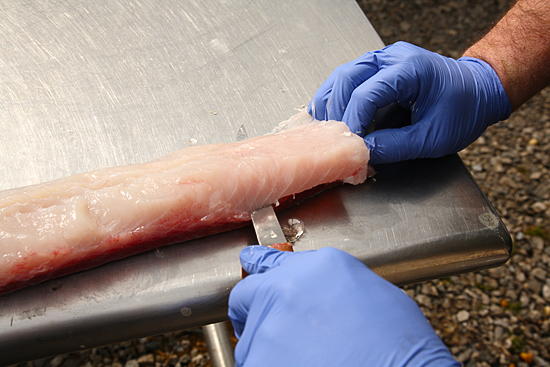BY Kevin Kelly
FRANKFORT, Ky. – Local food sources and sustainable food options are of increasing importance to today’s health-conscious consumers.
Kentucky offers anglers an abundance of fishable water with some of the best tasting fish nature has to offer, and a good day can provide a bounty for the dinner table and freezer for far less than you’re likely to pay in a supermarket or restaurant.
“Back in the 1970s and ‘80s the majority of people went fishing and ate what they caught,” said Ryan Oster, fisheries program coordinator with the Kentucky Department of Fish and Wildlife Resources. “We’ve swung so far to the opposite end of the pendulum nowadays that there are some fisheries out there that could probably benefit from people starting to harvest more of the fish that they’re catching.”

A low-fat source of protein rich in beneficial omega-3 fatty acids, fresh fish tastes even better when you are the one who caught, filleted and cooked it. But, the prospect of cleaning that catch can be intimidating for novice and experienced anglers alike.
Learning how to properly fillet a fish requires following a few simple steps that apply to most species of game fish in Kentucky. With some practice, and a little patience, perfect fillets can be had in no time, every time.
The process starts with proper care of the fish immediately after it’s been landed.
“If you’re going to keep fish to eat, really the best thing to do with a fish once you catch it is not put it on a stringer and let it dangle in the water,” Oster said. “Put it on ice right off the bat to help preserve the quality of the meat immediately.
“When you put fish on a stringer, that’s a real stressful event for a fish, and when you stress a fish you can really start to deteriorate the quality of the meat.”
Once you’re ready to fillet the fish, give it a quick rinse to remove excess slime and any dirt. Donning rubber gloves will improve your grip on the fish and cut down on the fish smell left on your hands.
A sharp-bladed fillet knife is a must, but it doesn’t have to cost a small fortune. A good one can be had for around $15 from catalog outfitters.
“A lot of people that I show how to fillet fish their first comment is, ‘Give me a dull knife because I don’t want to cut my finger off,’” Oster said. “That’s actually the worst knife you could have. A sharp knife makes the entire process of filleting a quick and easy process. With a really sharp knife all you have to do is put gentle pressure on it and the blade should cut through bone like butter.”
A 3-1/2 inch blade works well on bluegill, crappie and redear while larger blades in the 6-7 inch range are good for catfish, bass and walleye, Oster said.
To begin the filleting process, place the fish on its side on a firm, flat surface. Wood boards work well.
Securing the head with your free hand, make a cut behind the gill plate and pectoral fin from the top of the fish to the belly. People who consider themselves a novice should always remember to keep the knife blade pointed away from their body during the entire filleting process. Never turn the blade so that it is facing you. This helps ensure safety during the entire process.
Continue cutting into the flesh until the knife blade touches the backbone. Once it does, turn the knife 90 degrees so that the blade lies flat against the fish’s backbone, facing toward the fish’s tail. Cut through the ribs using the backbone as a guide but don’t cut all the way through to the tail. Leave 1-inch or so intact.
Next, flip the fillet over skin side down and work the blade into the fillet near the tail until the blade is between the fillet and the skin. Separate the skin from the meat by sliding the knife forward. Remove the rib cage from the skinless fillet and you’re done.
Repeat the process on the other side of the fish and discard the carcass and skin. Rinse the fillets in cold, clean water and keep the meat cool until ready to prepare. If you’re not going to cook the fish until the following day, Oster recommends storing the fillets in a plastic bag with water and a little salt added to it.
It’s best to freeze any fish that isn’t going to be used in two or three days. Some recommend quick freezing the fish by placing it uncovered on a sheet of aluminum foil in the freezer. Or you can simply place the fillets in a plastic freezer bag, fill it with water, seal and freeze to protect the meat from freezer burn.
A freezer full of fish means fresh never goes out of season. Remember, your 2013 fishing license expires at the end of this month, so buy your 2014 fishing license soon.
Kevin Kelly is a writer for Kentucky Afield magazine, the official publication of the Kentucky Department of Fish and Wildlife Resources. An avid angler with a passion for muskellunge and stream fishing, his journalism career has included stops at daily newspapers in Cincinnati, Ohio, St. Petersburg, Fla. and Charleston, S.C.
-30-
The Kentucky Department of Fish and Wildlife Resources manages, regulates, enforces and promotes responsible use of all fish and wildlife species, their habitats, public wildlife areas and waterways for the benefit of those resources and for public enjoyment. Kentucky Fish and Wildlife is an agency of the Tourism, Arts and Heritage Cabinet. For more information on the department, visit our website at fw.ky.gov.


Be the first to comment